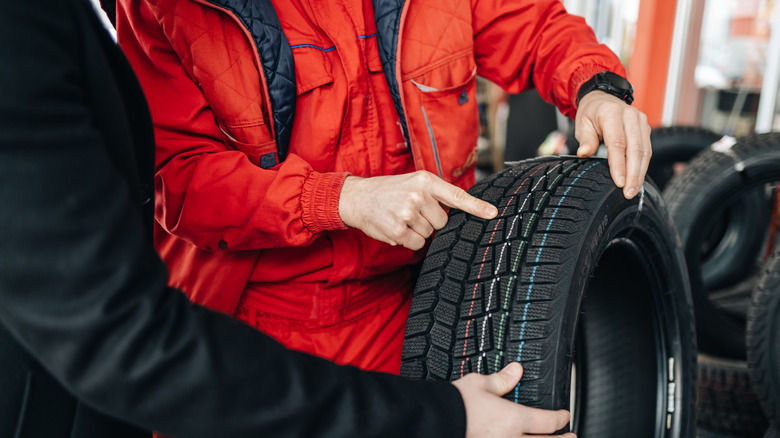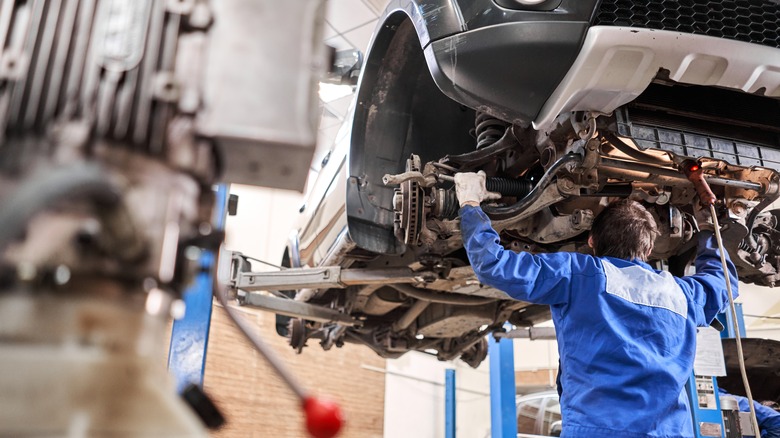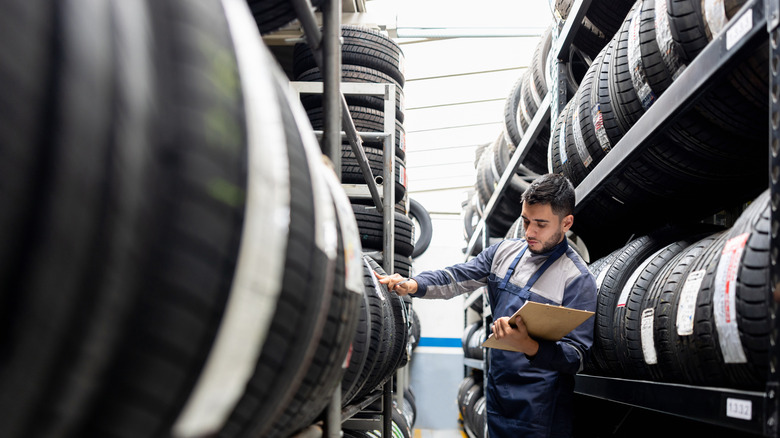5 Reasons Why Proper Tire Alignment And Rotation Is So Important
Whether you're driving a traditional car, an electric vehicle, or even a hybrid, there are some maintenance requirements that every driver should know about. Aside from learning about how to take better care of your engine, car owners also need to remember to manage the health of their tires.
To reduce tire failures or blowouts, the U.S. Department of Transportation (DOT) requires all passenger cars and light trucks to have an onboard tire pressure monitoring system (TPMS). TPMS monitors real-time tire pressure information, typically displayed as a gauge, pictogram, or low-pressure warning light.
However, other aspects of tire health still require drivers to deduce issues by themselves. Aside from tire pressure, your tire's health and safety can also be affected by its alignment and rotation.
According to Bridgestone, some common indicators of whether your car needs tire alignment include uneven tread wear, steering vibration, or when your steering wheel is off center. CEAT Tyres recommends opting for a wheel alignment whenever you change your vehicle's oil.
On the other hand, whether or not you're truly rotating your tires often enough depends on a variety of factors, such as your usage and car model. In general, it's recommended to rotate your tires by your vehicle's manufacturer. But as a rule of thumb, the Michelin Owner's Manual (PDF) recommends drivers should go at most 8,000 miles between rotations.
Here's why keeping up with both tire alignment and rotation matters.
Better fuel efficiency
Do healthier tires lead to longer miles? According to the United States Department of Energy (DOE), the answer is yes. Due to rolling resistance, the DOE shares that 20-30% of a vehicle's fuel consumption can be attributed to tires.
Tire rolling resistance is the amount of energy that your car needs to send to your tires in order for it to maintain movement at a consistent speed. Since tires sit between the rest of your car and the road, the small patch of tire that is connected to the road is called a "contact patch." The DOE shares that 35-50% of a tire's rolling assistance can be attributed to the tire tread.
If you don't rotate your tires, it can lead to imbalance wearing out, making it easier for the car to slip more and cause the engine to work harder to move in the right direction. Since the engine will need to work harder to offset your worn-out tires, it needs to utilize more gas per mile compared to when you're driving with properly maintained tires.
Aside from rolling resistance, the DOE also mentions other factors like road quality, vehicle weight, and air drag, affecting overall fuel economy.
Improved safety
When a car tire fails, it can lead to disastrous consequences. The National Highway Traffic Safety Administration (NHTSA) shares that tire defects cause an average of 11,000 car accidents annually in the United States. In 2021, the NHTSA also claims that 622 people died on the road due to tire-related crashes.
Unfortunately, tire failure can be caused by the manufacturing process, at the tire shop, or other unrelated road-related issues. Some of the most common causes of tire failure include tread separation, tires made without specified components, improper puncture repair, and damage during the mounting process.
However, it's also possible that your tire will experience issues because of completely preventable things like not rotating it enough, wherein some tires look okay, but others are worn down. Additionally, irregular rotation can lead to tire pressure loss, which could turn into a sudden blowout.
By regularly rotating your tires, you can also spot other safety-related issues with your tires before they cause any unexpected trouble. Mechanics will also be able to identify if other repairs done to your tires are substandard or if DIY repairs are causing any unexpected issues.
Less suspension damage
Poor alignment may not cause any immediate damage to your suspension, but it could potentially lead to long-term issues. In a poorly aligned vehicle, your wheels aren't all facing the same direction. This can alter how the shocks function, wearing parts out sooner and leading to an uncomfortable riding experience.
In the early stages, it can be difficult to tell if your suspension is damaged or not. If you haven't been serious about keeping your tires aligned, some suspension issue-related signs you should watch out for include feeling like your car is bouncing or sliding on winding roads, bouncing after a speed bump, or making clunky noises when you pass a bump.
However, in some cases, suspension issues can be due to manufacturing issues more than your poor tire alignment or rotation practices. In 2017, the NHTSA shared a Tesla technical service bulletin [PDF] stating, "Some Model S and Model X vehicles may have been manufactured with front suspension fore links that may not meet Tesla strength specifications." Five years later, a lawsuit was filed after a Tesla Model 3 suffered a suspension failure that led to the death of two people.
Steer system longevity
One of the most immediate effects of bad tire alignment is having your wheel off-center, making steering difficult to control and causing accidents. Not to mention, misalignment or an imbalance with your tires can also put you at risk of steering wheel vibration or shaky steering. However, it's important to differentiate wheel shaking designed as a warning mechanism by modern lane assistance systems.
If it's not your tire alignment causing issues, steering your car may be difficult because of low power steering fluid levels, a bad steering rack, or power steering pump failure. Alternatively, your steering wheel may have just been installed incorrectly.
By watching for signs that your wheels need alignment, you can maintain a generally more stable vehicle handling experience, whether for city driving or off-road adventures. Just make sure to avoid potholes, or you might just need to see a mechanic sooner rather than later.
Keep your tires healthy
If you need to check if your vehicle is due for an alignment or rotation, you can ask for a professional opinion. In the United States, Goodyear offers free inspection to check if your vehicle's alignment meets your manufacturer's specs.
Aside from keeping your tires aligned and regularly rotating them, there are plenty of other habits you should stop that can slash the lifespan of your tires, such as hitting the curb, not checking tire pressure, and using the wrong tires of the season.
In fact, the NHTSA also reminds drivers that car tires can be recalled as well. So, if you suspect something is wrong with your tires, you can check for any known safety issues and recalls on its website. Additionally, you can also file complaints for any issues if you suspect they were caused by your tire or car's manufacturer and not by your daily use.





